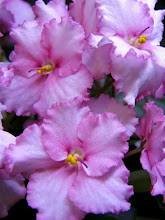
Well, with two catalog orders now in the ground, and one additional purchase from a local plant seller, the garden is really starting to kick things off with some beautiful flowers! There is still a lot of filling out for my little plants to do, but all in good time. I am so pleased with the plants I have acquired!

The Allium show has just about come to an end. The final blooms are just begininng to wane. Now that the garden area around them has more plant life, I plan on relocating these so they are no longer lining the fence. It just looks wierd with the more relaxed layout of the rest of the bed.

The flower bed now contains Purple Coneflower, Painted Daisies, Shasta Daisies, some beautiful and dainty Arctic Fire Dianthus that I absolutely LOVE (left), Russian Sage, Red Creeping Sedum, Japanese Blood Grass, two colors of Coreopsis - one red one yellow (yellow pictured below)....


I found a couple of plants that I hadn't heard of that I have completely fallen in love with. One of these is Gaura,
(Gaura lindheimeri). The variegated leaves are beautiful on its irregular upright shape, and each stalk is topped with the most elegant flowers in shades of pink and white. It is now one of my favorites!
The Orchid Frost Lamium is beginning to take off around the pond. I love the foam green leaves and pretty pink flowers. I've also added Korean Feather Reed Grass, Bleeding Hearts, Ajuga, and Liriope to help fill in around the pond. I think I may also transplant some Vinca from other parts of the yard to help fill it in. It is just so shady and weedy back there, but I don't dare pull all the weeds yet or it will
really look bare!


As well as new additions, I have also done some rearranging around the pond. My Caladium seemed to be getting scorched, so I moved it back and put the little autumn-toned Geranium in its place. Both seem to be happy so far in their new locations.
I had ordered a beautiful Monet Coralbell that I put back there, but it completely withered. I'm wondering if it was due to lack of sun, so I have moved it forward to an area where another coral bell of mine is thriving. I hope it comes back! It was one of the plants I was most looking forward to!




.jpg)

.jpg)















.jpg)
.jpg)
.jpg)












































